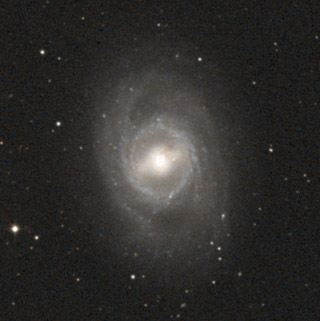 Messier
95 is a face-on barred-spiral galaxy that makes a famous pair with
its neighbor, M96. Both were discovered by Mechain on March
20, 1781. These two galaxies, the nearby NGC 3379, NGC 3384,
NGC 3389 and possibly the other Messier pair in Leo (M65 and M66)
are all part of the Leo galaxy cluster, lying about 30-40 million
light year distant. That's about 15 times farther away than
the Local Group member M31 (this is still quite nearby). Messier
95 is a face-on barred-spiral galaxy that makes a famous pair with
its neighbor, M96. Both were discovered by Mechain on March
20, 1781. These two galaxies, the nearby NGC 3379, NGC 3384,
NGC 3389 and possibly the other Messier pair in Leo (M65 and M66)
are all part of the Leo galaxy cluster, lying about 30-40 million
light year distant. That's about 15 times farther away than
the Local Group member M31 (this is still quite nearby).
Of the M95/96 pair
Walter Scott Houston wrote uncharacteristically that "They are
not breathtaking (to say the least) and for users of small
telescopes a good description is that they are bright enough to be
seen." But don't let that bland description turn you away
from this pair; there is more to them that first meets the eye.
M95 is the westernmost
member of this pair of bright galaxies which are separated by about
42', putting them in the same field of view for scopes capable of
wide field views. Smyth described it as a "lucid
white nebula... round and bright." It has a distinctly
bright, starlike core.
In my 18-inch the best
view of M95 came at 94x. The bright stellar core was very
distinct. The elongated haze of the galaxy had superimposed
upon it a brighter rounder inner region. Photographs of this
galaxy show a round galactic bulge with large bars extending out to
a round ring. I wonder, if the galaxy appeared elongated to
me, is that because I was seeing the bars? If so, I wonder
what aperture is required to "see" this feature? I
have read some reports on the web that suggest the bar is an easy
feature. The next chance I get I'll try to verify the shape
and direction of the visual feature. You can do this yourself
using the image here as a guide. 
The field in an 6-inch f/8 at
50x. North is down and east is to the right. |